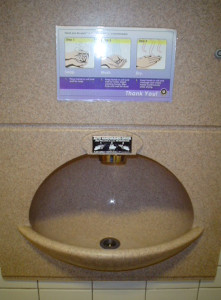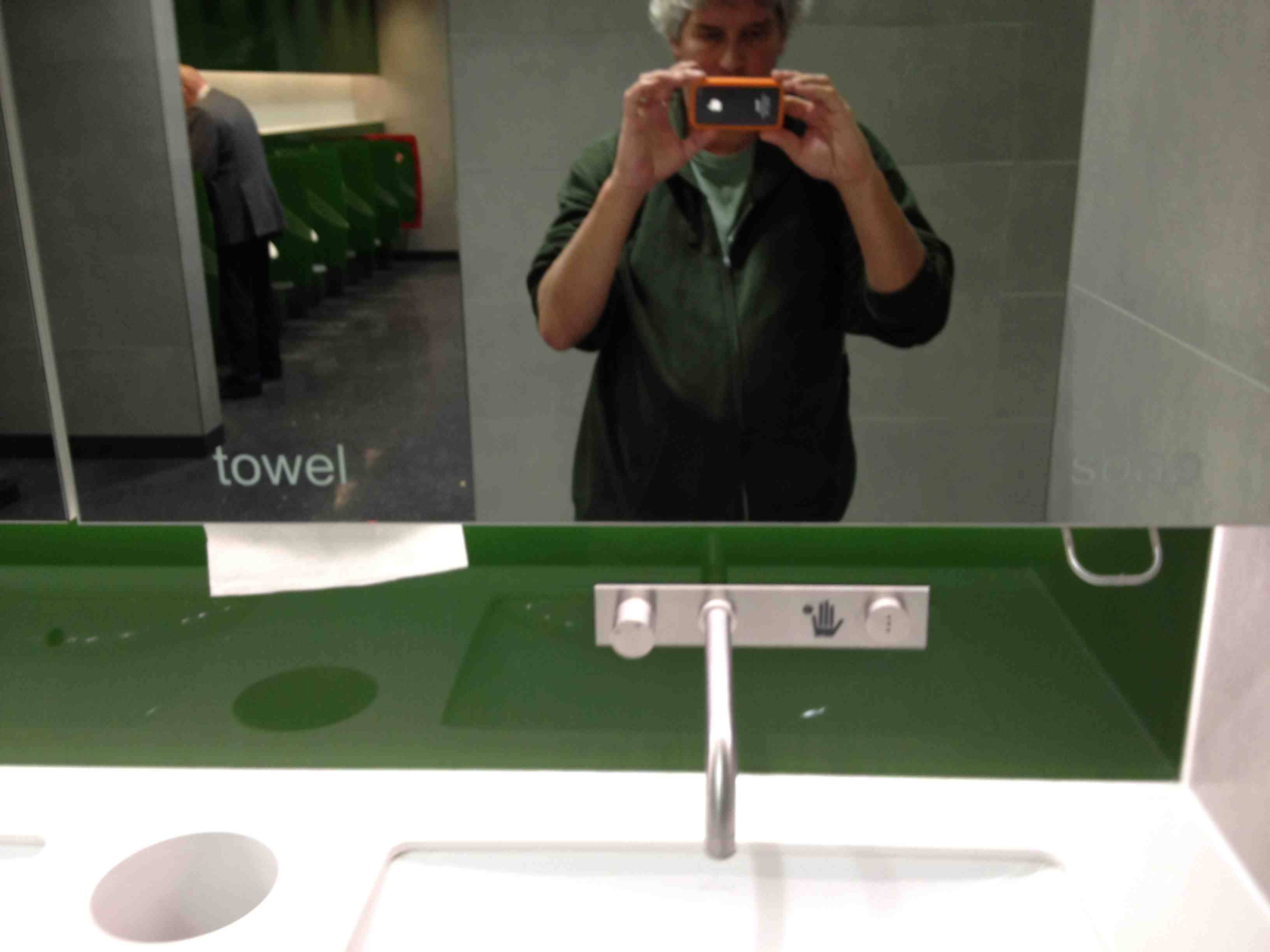What’s better, washing with soap and water and drying with paper towel, or using a sanitizer?
About 10 years ago the consensus was leaning toward sanitizers because of convenience and mobility. But new studies questioning the effectiveness of various sanitizers means handwashing has become fashionable yet again.
Are sanitizers better than nothing? Probably, in places like hospitals, but not so much on farms where organic matter – dirt and poop – rapidly reduce the .jpg) effectiveness of sanitizers.
effectiveness of sanitizers.
In the wake of an outbreak of cryptosporidium linked to a live lambing event in Wales that has sickened at least 13, the U.K. Health Protection Agency (HPA) has warned anyone who is visiting an open farm over the Easter weekend not to rely on sanitizing hand gels or wipes to protect themselves or their children against germs that may be present in animal dirt around the farm.
Although the risk of becoming unwell is very low in light of the millions of farm visits every year there are, on average, around three outbreaks of gastrointestinal disease which are linked to visits to petting farms. The route of infection in these outbreaks is generally through contact with germs from animal droppings. These germs can be ingested when people, especially children, put their fingers in their mouths.
To reduce the risk of illness, both adults and children should thoroughly wash their hands using soap and water after they have handled animals or touched surfaces at the farm and always before eating or drinking. Hand gels can’t remove contamination in the manner that soap and water can.
Research published by the HPA of a review of 55 outbreaks of intestinal disease linked to petting farms between 1992 and 2009 showed that one of the risk factors associated with illness was the reliance on hand gels instead of handwashing. Over the 17 year period of the study, 1,328 people were reported to have fallen ill following a farm visit, of whom 113 were hospitalised. Illness ranged from mild through to severe diarrhoea and occasionally more serious conditions.
Over half of the 55 outbreaks in the study, 30 (55 per cent) were caused by E. coli O157 (VTEC O157) and a further 23 (42 per cent) were caused by cryptosporidium. The remaining two (three per cent) outbreaks were caused by a type of salmonella.
Other risk factors noted in the research are which have been linked to outbreaks include bottle feeding lambs and thumb sucking by children. The full research paper can be found in Emerging Infectious Diseases 2010 Gormley et al. ‘Transmission of Cryptosporidium spp. at petting farms, England and Wales’ http://www.cdc.gov/ncidod/eid/
Hand gels have their use in areas which are generally clean, for example offices or hospitals, but are not effective in killing bugs such as E. coli or cryptosporidium which can be found in animal droppings and on contaminated surfaces around farms.
Except there may be some BS in the cleanest offices.
The U.S. Food and Drug Administration (FDA) reported yesterday that some hand .jpeg) sanitizers and antiseptic products come with claims that they can prevent MRSA (methicillin-resistant Staphylococcus aureus) infections.
sanitizers and antiseptic products come with claims that they can prevent MRSA (methicillin-resistant Staphylococcus aureus) infections.
Don’t believe them. These statements are unproven, says FDA.
“Staphylococcus aureus itself is a very aggressive organism,” says Edward Cox, M.D., M.P.H., director of FDA’s Office of Antimicrobial Products. “It’s often associated with patients in hospitals who have weakened immune systems, but the bacterium can also cause significant skin infections and abscesses in a normal, healthy person. And it can get into the bloodstream and, less frequently, may involve the heart valve, which is very difficult to treat.”
But this antibiotic-resistant strain is even more difficult to treat. “With MRSA, a number of the antibiotic drugs we typically used often don’t work, so we lose treatment options we used to rely upon,” says Cox.
FDA is cracking down on companies that break federal law by promoting their products as preventing MRSA infections and other diseases without agency review and approval.
“Consumers are being misled if they think these products you can buy in a drug store or from other places will protect them from a potentially deadly infection,” says Deborah Autor, compliance director at FDA’s Center for Drug Evaluation and Research.
FDA wants consumers to watch out for unproven product claims, too—whether they buy a product from a retail store or through the Internet.
Examples of unproven claims found on product labels are
* kills over 99.9% of MRSA
* helps prevent skin infections caused by MRSA and other germs
* is effective against a broad spectrum of pathogens, including MRSA
One company claims that its hand sanitizing lotion prevents infection from the bacterium E. coli and the H1N1 flu virus. And another firm claims its “patented formulation of essential plant oils” kills the bacterium Salmonella. These claims are also unproven and, therefore, illegal.
“FDA has not approved any products claiming to prevent infection from MRSA, E. coli, Salmonella, or H1N1 flu, which a consumer can just walk into a store and buy” says Autor. “These products give consumers a false sense of protection.”
 They are my go-to sweat rags, hand wipes and kitchen cleaner-uppers.
They are my go-to sweat rags, hand wipes and kitchen cleaner-uppers. Experts discourage using kitchen towels for multiple purposes (wiping utensils, drying hands, holding hot utensils, wiping/cleaning surfaces) because they had a higher bacterial count than single-use towels. They also warn against using humid towels because they too showed higher bacterial count than dry ones. Pathogens on kitchen towels would indicate that they could bear some responsibility for cross-contamination in the kitchen and, ultimately, food poisoning. Households with children, older adults or others with immunosuppression should be especially vigilant about hygiene in the kitchen.
Experts discourage using kitchen towels for multiple purposes (wiping utensils, drying hands, holding hot utensils, wiping/cleaning surfaces) because they had a higher bacterial count than single-use towels. They also warn against using humid towels because they too showed higher bacterial count than dry ones. Pathogens on kitchen towels would indicate that they could bear some responsibility for cross-contamination in the kitchen and, ultimately, food poisoning. Households with children, older adults or others with immunosuppression should be especially vigilant about hygiene in the kitchen.






 Wisconsin, 48-17.
Wisconsin, 48-17..jpg) effectiveness of sanitizers.
effectiveness of sanitizers..jpeg) sanitizers and antiseptic products come with claims that they can prevent MRSA (methicillin-resistant Staphylococcus aureus) infections.
sanitizers and antiseptic products come with claims that they can prevent MRSA (methicillin-resistant Staphylococcus aureus) infections. confusing.
confusing.(2).jpg) dryers, the model that rapidly stripped the moisture off the hands was best for reducing transfer of bacteria to other surfaces.
dryers, the model that rapidly stripped the moisture off the hands was best for reducing transfer of bacteria to other surfaces. that’s up from 45 percent in 2009 when the same question was asked.
that’s up from 45 percent in 2009 when the same question was asked. bacterial growth. The volunteers were then asked to dry their hands using either hand towels or one of three hand dryers, with or without rubbing their hands together, and levels of bacteria were re-measured.
bacterial growth. The volunteers were then asked to dry their hands using either hand towels or one of three hand dryers, with or without rubbing their hands together, and levels of bacteria were re-measured.